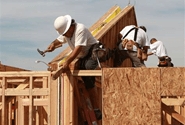Steel Markets

Housing Starts Fall After a Rousing January
Written by Sandy Williams
March 25, 2019
Housing starts took a tumble in February, dropping 8.7 percent below January’s level for a seasonally adjusted annual rate of 1,162,000. Single-family starts plummeted 17.0 percent, although apartment-style housing of five units or more jumped 23.5 percent. Starts declined in all regions except the Midwest, which saw a gain of 26.8 percent for the month.
“The overall lower starts numbers are somewhat deceiving given the revised single-family starts figure in January was at a post-recession high,” said Danushka Nanayakkara-Skillington, AVP for Forecasting and Analysis at the National Association of Home Builders. “Absent the surge last month, the drop in single-family production in February is not as huge as it appears. Still, builders continue to remain cautious due to affordability concerns, as illustrated by the flat permits data.”
Permit authorizations were also down, but at a much smaller rate. Permits dipped 1.6 percent from January and 2.0 percent from a year ago. Total permit authorizations were at a SAAR of 1,296,000. Single-family authorizations stayed at the same rate as January at 821,000.
Greg Ugalde, chairman of NAHB, said February starts are “somewhat in line with flat builder expectations and serve as a cautionary note that affordability factors continue to affect the marketplace.”
Negative affordability factors include excessive regulations, a scarcity of buildable lots, persistent labor shortages and tariffs on lumber and other key building materials, he added.

Sandy Williams
Read more from Sandy WilliamsLatest in Steel Markets

CMC looks beyond Arizona micro-mill woes to long-term viability of construction mart
Despite the economic and geopolitical upheaval of the last five years, CMC President and CEO Peter Matt points out that the construction market has been an essential element of the way forward.

US importers face stricter rules under revamped S232 tariffs
“CBP expects full compliance from the trade community for accurate reporting and payment of the additional duties. CBP will take enforcement action on non-compliance," the agency said in a March 7 bulletin.

Steel exports rebound in January
US steel exports recovered to a five-month high in January after having fallen to a two-year low in December. This growth follows four consecutive months of declining exports.

Construction spending drops marginally in January
Construction spending edged down slightly in January, slipping for the first time in four months. The US Census Bureau estimated spending at a seasonally adjusted annual rate of $2,196 billion in January, down 0.2% from December’s downward revised rate. The January figure is 3.3% higher than a year ago. January’s result, despite the slight erosion, […]

HVAC equipment shipments slow in December but strong annually
Shipments of heating and cooling equipment in the US fell to an 11-month low in December, according to the latest data released by the Air-Conditioning, Heating, and Refrigeration Institute (AHRI).
